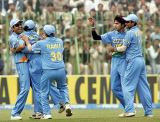
|

Attacking field settings helped India apply a lot of pressure on Pakistan
© Getty Images
|
|
What makes a winning total today? In 1982-83, New Zealand made 297 for six
to beat England at Adelaide. The record remained until New Zealand
bettered it by one run, also against England in 1990, although they had 55
overs in which to do it. Since then, a target of over 300 has been
successfully hunted down by the side batting second 13 times. Apart from
when Sri Lanka chased 312 against Zimbabwe in the 1992 World Cup, it
shouldn't surprise anyone that all chases have come after 1996, the year
in which Sanath Jayasuriya turned ODI batting upside down.
Inzamam-ul-Haq said, after his side almost chased 350 against India two
years ago, that no total is safe anymore and he reiterated it before the
start of this series. Duckworth and Lewis ensured we will never know
whether or not Pakistan could have pulled off the third-highest run chase
ever but they ended mighty close anyway. Inzamam of course says it with
the comfort of a batting line-up as deep as any ocean. It isn't just the
depth that is frightening; the versatility in it is astonishing.
Not until the dying stages of the game, in its last ten overs, did the
total remotely look threatening. Until then, Pakistan were coasting;
Salman Butt provided the impetus and a platform with a wonderfully punchy
century, his third in ODIs and all against India. But arguably the innings
of the match came from his collaborator, Shoaib Malik, in a 151-run
partnership. Malik's versatility reflects, broadly that of Pakistan's. For
his first 50 runs, off 49 balls, he ran hard, picked singles and on a
small ground crying for big hits, made only half his runs in boundaries.
His second 40 runs were bludgeoned from 18 balls and of those balls, seven
were boundaries. For timing and pacing, it was criminally good and as long
as he was there, he marshaled Pakistan's chase.
Even when both departed, at 233 for three, with Inzamam, Afridi, Yousuf,
Younis, Razzaq all to come, it threatened to be a stroll. That they came
so close to losing it and were eventually relieved for bad light which loomed through the day, was due almost entirely to Rahul Dravid's outrageously courageous captaincy.
These can't be easy times for Dravid; with the Chappell and Ganguly affair
still spluttering, it has been easy to overlook the predicament he is in.
It's a shame for it has deflected the spotlight from a wonderfully astute
captain.
When both were out, Dravid sniffed and immediately brought in his
fielders. Five men were kept in the circle, long-on and long-off, on a
small ground, became mid-on and mid-off, a slip was posted (and he had one
even as late as the 46th over) and Pakistan were invited to hit over the
top. Bowlers were used for only short bursts and the changes brought wickets.
The fielding sharpened, one run-out and numerous mix-ups resulted and
Pakistan nearly faltered.
He did have a good total to defend, admittedly, and the remainder of this
series is as likely to rest on whose batting line runs deeper; India's is
not far different from Pakistan's. They might even be more flexible and as
Sachin Tendulkar methodically picked off his runs and critics, around him
emerged two casually violent innings, not for the first time, from Irfan
Pathan and Mahendra Singh Dhoni. With Yuvraj Singh, Rahul Dravid and
Mohammad Kaif to come, India could and should have reached much beyond
what they ended with. In any case, it reinforced the belief that the depth
and vitality that first surfaced against Sri Lanka in particular was not
just a passing phase.
To be honest, it looked from today, that if the series does hinge on a
bowling performance, it is likelier to be a Pakistani one. Bowling, though
essentially a bit-part occupation here, had some honest Indian
representation. Zaheer, Pathan and Agarkar all toiled. But the only
periods when the ball controlled and troubled the bat was when it was in
the hands of Mohammad Asif throughout his spell and Rana Naved-ul-Hasan at
the end of the innings.
Asif continued, in nearly every sense, from where he had left off in
Karachi. He seamed the ball, bounced it, varied his length and in
conceding just over three runs in an over in a match in which six was the
norm, displayed an adaptability in discipline that was remarkable. Rana's
finishing spell was pure ODI death; yorkers on demand, key wickets and
shared responsibility for India ending well short of what they would have
wanted. How much of a part they, or any bowler will play in this series
though, is likely to be overshadowed by the question that began this
article.
Osman Samiuddin is Pakistan editor of Cricinfo

